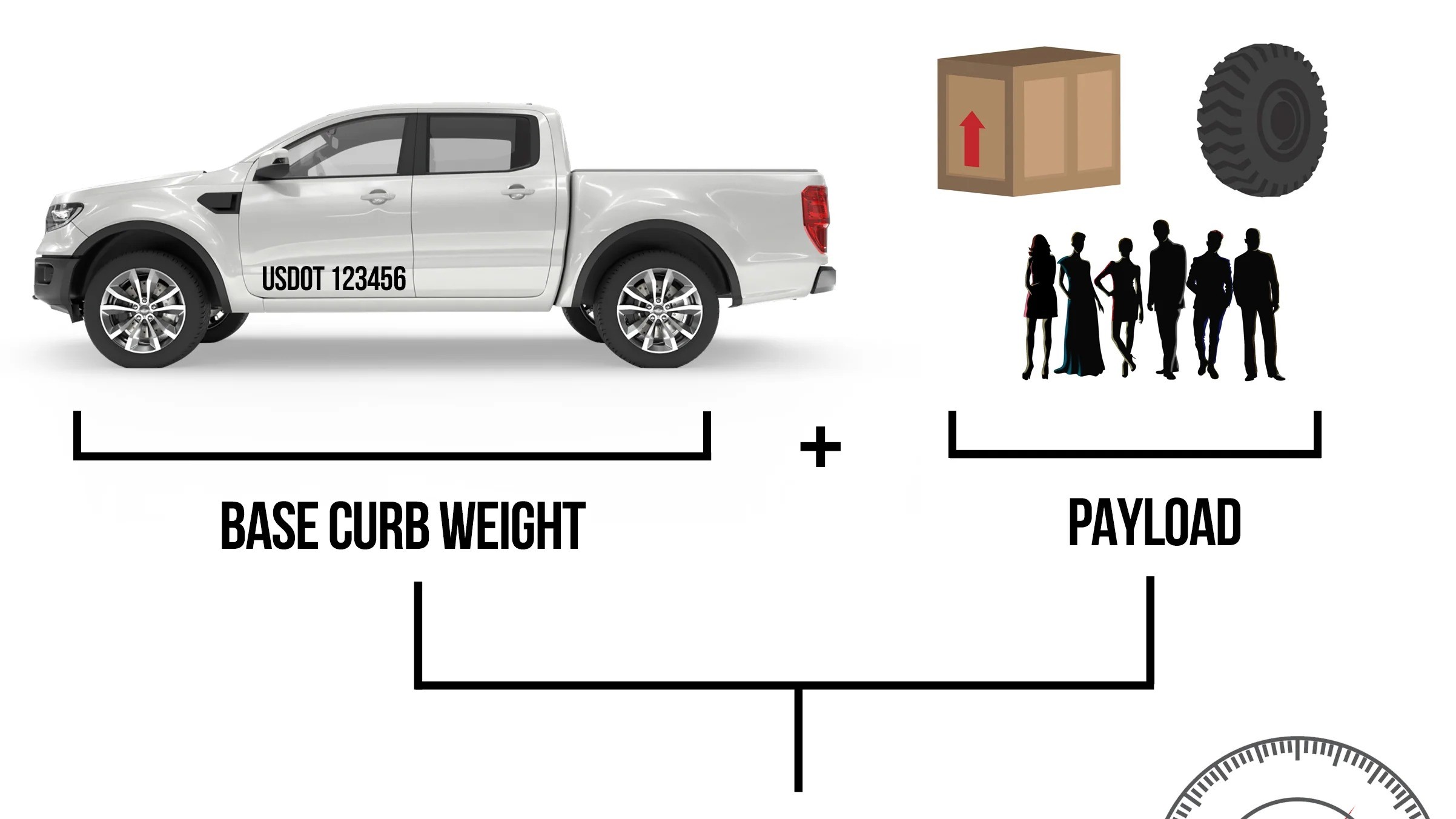Home>Automotive>The Surprising Truth About Curb Weight Vs. Gross Weight


Automotive
The Surprising Truth About Curb Weight Vs. Gross Weight
Published: February 14, 2024
Discover the difference between curb weight and gross weight in the automotive industry. Uncover the surprising truth and make informed decisions.
(Many of the links in this article redirect to a specific reviewed product. Your purchase of these products through affiliate links helps to generate commission for Noodls.com, at no extra cost. Learn more)
Table of Contents
Introduction
When it comes to understanding the dynamics of vehicles, the terms "curb weight" and "gross weight" play a pivotal role. These two concepts are fundamental in the automotive industry, influencing everything from vehicle performance to safety and fuel efficiency. While many drivers may have a general idea of what these terms entail, delving deeper into their significance can reveal surprising insights.
In this article, we will unravel the intricate relationship between curb weight and gross weight, shedding light on their individual meanings and the impact they have on various aspects of vehicle operation. By gaining a comprehensive understanding of these concepts, drivers can make informed decisions about their vehicles, ensuring optimal performance and safety on the road.
Join us as we embark on a journey to demystify the world of curb weight and gross weight, uncovering the surprising truths that lie beneath the surface. Whether you're a seasoned automotive enthusiast or a casual driver, this exploration promises to unveil valuable insights that can transform the way you perceive and interact with vehicles. So, fasten your seatbelts and get ready to explore the fascinating realm of curb weight and gross weight!
Read more: The Surprising Truth: Guys’ True Priority Revealed – Weight And Dress Size Vs. Confidence
Understanding Curb Weight
Curb weight, also known as kerb weight, refers to the total weight of a vehicle when it is fully equipped with all standard equipment, fuel, oil, and other necessary operating fluids. This weight measurement excludes the weight of any passengers or cargo. Essentially, curb weight represents the mass of the vehicle as it sits stationary on the curb, ready for operation.
Understanding curb weight is crucial for several reasons. Firstly, it serves as a fundamental parameter for assessing a vehicle's performance and capabilities. A lighter curb weight often translates to improved fuel efficiency, agility, and handling, making it a desirable attribute for many drivers. Additionally, manufacturers use curb weight as a reference point for determining the vehicle's load capacity and towing capabilities. By knowing the curb weight, drivers can make informed decisions about the amount of cargo or passengers their vehicle can safely accommodate.
Moreover, curb weight plays a significant role in vehicle safety. It directly impacts braking distances, stability, and overall handling characteristics. Heavier vehicles tend to have longer braking distances and may exhibit reduced maneuverability, especially in emergency situations. Therefore, understanding the curb weight of a vehicle is essential for gauging its safety performance and making adjustments to driving behavior as necessary.
In the context of automotive design and engineering, curb weight serves as a critical factor in achieving regulatory compliance and meeting industry standards. It influences the selection of materials, structural design, and overall vehicle architecture. Engineers strive to optimize curb weight to enhance fuel efficiency, reduce emissions, and improve overall performance without compromising safety or structural integrity.
In summary, curb weight is a foundational metric that influences various aspects of vehicle design, performance, and safety. By comprehending the significance of curb weight, drivers can make informed choices when selecting a vehicle, understanding its capabilities, and ensuring safe and efficient operation on the road.
Understanding Gross Weight
Gross weight, also referred to as gross vehicle weight (GVW), pertains to the total weight of a vehicle, including its curb weight, passengers, cargo, and any additional accessories or modifications. Essentially, it represents the maximum allowable weight that a vehicle can safely carry while in operation. Understanding gross weight is paramount for ensuring compliance with safety regulations, optimizing vehicle performance, and maintaining operational integrity.
The concept of gross weight encompasses the combined mass of the vehicle's components, occupants, and any load it carries. This comprehensive measurement serves as a critical parameter for determining a vehicle's load-carrying capacity and its ability to operate safely under varying conditions. By accounting for the total weight exerted on the vehicle's suspension, tires, and braking system, gross weight plays a pivotal role in assessing the vehicle's stability, handling characteristics, and overall safety performance.
For commercial vehicles, such as trucks and buses, adhering to specified gross weight limits is essential for regulatory compliance and road safety. Exceeding the designated gross weight threshold can compromise vehicle stability, increase braking distances, and accelerate wear and tear on critical components, posing significant hazards to both the driver and other road users. Therefore, drivers and fleet operators must meticulously manage and monitor the gross weight of their vehicles to ensure adherence to legal requirements and mitigate potential safety risks.
In the context of passenger vehicles, understanding gross weight is equally crucial. Overloading a vehicle beyond its designated gross weight capacity can lead to diminished handling, compromised braking efficiency, and increased susceptibility to rollover accidents. Moreover, exceeding the recommended gross weight limit may void the vehicle's warranty and insurance coverage, exposing drivers to potential liabilities in the event of accidents or mechanical failures.
From a design and engineering perspective, gross weight serves as a fundamental consideration in vehicle development. Engineers meticulously evaluate the distribution of weight across the vehicle's chassis, suspension, and braking system to ensure optimal performance and safety under varying load conditions. By conducting rigorous testing and analysis, manufacturers strive to establish maximum gross weight limits that align with regulatory standards while delivering a balance of performance, durability, and safety.
In essence, understanding gross weight is essential for drivers, fleet operators, and automotive engineers alike. By comprehending the significance of gross weight and its implications for vehicle safety and performance, individuals can make informed decisions regarding load management, operational practices, and vehicle design, ultimately contributing to safer, more efficient transportation systems.
The Difference Between Curb Weight and Gross Weight
Curb weight and gross weight represent distinct yet interconnected aspects of a vehicle's overall mass and operational characteristics. Understanding the disparity between these two measurements is crucial for drivers, engineers, and regulatory authorities, as it underpins critical considerations related to vehicle performance, safety, and compliance.
At its core, the primary disparity between curb weight and gross weight lies in the scope of their inclusivity. Curb weight exclusively accounts for the mass of the vehicle itself, encompassing all standard equipment, fuel, and operational fluids, while excluding passengers and cargo. In contrast, gross weight extends beyond the vehicle's intrinsic mass to encompass the cumulative weight of the vehicle, occupants, cargo, and any additional accessories or modifications.
The distinction between these measurements is pivotal in assessing a vehicle's load-carrying capacity and operational limits. Curb weight serves as a baseline reference for evaluating a vehicle's intrinsic characteristics, such as fuel efficiency, handling, and performance, devoid of external factors. Conversely, gross weight provides a comprehensive overview of the total weight exerted on the vehicle during operation, encompassing dynamic variables such as passenger occupancy and cargo load.
Furthermore, the difference between curb weight and gross weight holds significant implications for safety and regulatory compliance. Curb weight influences a vehicle's static attributes, such as braking distances, stability, and maneuverability, while gross weight directly impacts dynamic factors, including suspension load, braking efficiency, and overall stability under varying load conditions. By discerning the disparity between these measurements, drivers can make informed decisions regarding load management, ensuring compliance with gross weight limits and mitigating safety risks associated with overloading.
From an engineering standpoint, the disparity between curb weight and gross weight underscores the multifaceted considerations involved in vehicle design and development. Engineers meticulously evaluate the distribution of weight across the vehicle's structure, suspension, and braking system to optimize performance and safety under diverse load scenarios. By recognizing the disparity between these measurements, manufacturers can refine vehicle architectures, establish gross weight limits, and enhance safety features to align with regulatory standards and operational requirements.
In essence, the difference between curb weight and gross weight transcends mere numerical variances, encapsulating fundamental distinctions in the scope, implications, and applications of these weight measurements. By comprehending this disparity, stakeholders can navigate the complexities of vehicle operation, design, and regulation with heightened awareness and precision, ultimately fostering safer, more efficient transportation ecosystems.
Factors Affecting Curb Weight and Gross Weight
The curb weight and gross weight of a vehicle are influenced by a myriad of factors, each playing a pivotal role in shaping the overall mass, performance, and safety characteristics of the vehicle. Understanding these influential factors is essential for drivers, engineers, and regulators, as it provides insights into the complexities of vehicle design, operation, and compliance.
Vehicle Size and Construction
The physical dimensions and construction of a vehicle significantly impact its curb weight and gross weight. Larger vehicles, such as SUVs and trucks, often exhibit higher curb weights due to the robust structural components and enhanced safety features required to accommodate their size. Similarly, the construction materials used, such as lightweight alloys or advanced composites, can influence curb weight, allowing manufacturers to achieve a balance between strength, safety, and fuel efficiency.
Powertrain and Engine Configuration
The type of powertrain and engine configuration installed in a vehicle can exert a substantial influence on its curb weight and gross weight. Vehicles equipped with larger displacement engines, complex drivetrains, or advanced propulsion systems may exhibit higher curb weights due to the additional components and structural reinforcements required to support these powertrains. Moreover, the inclusion of alternative fuel systems, such as electric or hybrid technologies, can impact gross weight by introducing battery packs or supplementary components.
Safety and Comfort Features
The integration of safety and comfort features contributes to the curb weight and gross weight of a vehicle. Advanced safety technologies, such as airbag systems, collision avoidance systems, and reinforced impact zones, add mass to the vehicle, influencing both curb weight and gross weight. Similarly, luxurious amenities and entertainment systems contribute to the overall weight of the vehicle, affecting its gross weight when occupied by passengers and cargo.
Payload and Towing Capacities
The designated payload and towing capacities of a vehicle are intrinsic determinants of its gross weight limits. Vehicles engineered for heavy-duty applications, such as trucks and commercial vans, are designed with robust chassis, suspension systems, and powertrains to accommodate substantial payloads and towing loads. Consequently, these vehicles often exhibit higher curb weights and gross weights to ensure operational integrity and safety under demanding conditions.
Regulatory Standards and Emissions Requirements
Stringent regulatory standards and emissions requirements exert a profound influence on the curb weight and gross weight of vehicles. Manufacturers must adhere to prescribed safety regulations, emissions targets, and load-carrying capacity limits, necessitating meticulous engineering and design considerations to achieve compliance. These standards directly impact the curb weight and gross weight of vehicles, shaping their structural composition, safety features, and overall operational capabilities.
In summary, the interplay of vehicle size, powertrain configuration, safety features, payload capacities, and regulatory standards collectively shapes the curb weight and gross weight of vehicles. By recognizing the multifaceted factors influencing these weight measurements, stakeholders can gain a comprehensive understanding of the intricate dynamics that underpin vehicle design, performance, and safety.
Importance of Knowing Curb Weight and Gross Weight
Understanding the curb weight and gross weight of a vehicle holds paramount significance for drivers, engineers, and regulatory authorities, as it underpins critical considerations related to vehicle performance, safety, and compliance. By delving into the importance of knowing these weight measurements, stakeholders can gain valuable insights into the operational dynamics and regulatory implications that shape the automotive landscape.
Safety and Operational Integrity
Knowledge of curb weight and gross weight is instrumental in ensuring the safety and operational integrity of vehicles. By comprehending the curb weight, drivers can gauge a vehicle's inherent characteristics, such as handling, braking distances, and fuel efficiency. This understanding empowers drivers to make informed decisions regarding load management, optimizing safety and performance on the road. Similarly, awareness of gross weight limits enables drivers to avoid overloading their vehicles, mitigating safety risks and preserving the structural integrity of critical components.
Regulatory Compliance
For both commercial and passenger vehicles, adherence to prescribed curb weight and gross weight limits is essential for regulatory compliance. Understanding these weight measurements allows manufacturers to design vehicles that align with safety standards, emissions regulations, and load-carrying capacity requirements. By adhering to these regulatory parameters, manufacturers and drivers contribute to a safer, more sustainable transportation ecosystem, fostering compliance with legal mandates and industry best practices.
Performance Optimization
Knowledge of curb weight and gross weight facilitates performance optimization for vehicles. By understanding the impact of curb weight on fuel efficiency, handling, and agility, drivers can make informed choices when selecting a vehicle that aligns with their performance preferences. Similarly, engineers leverage insights into gross weight to refine vehicle architectures, establish load-carrying capacities, and enhance safety features, ultimately optimizing the performance and durability of vehicles under diverse operating conditions.
Load Management and Efficiency
For commercial operators and fleet managers, awareness of curb weight and gross weight is indispensable for efficient load management. By understanding the maximum allowable gross weight for their vehicles, operators can optimize cargo distribution, minimize fuel consumption, and ensure compliance with weight regulations. This proactive approach to load management not only enhances operational efficiency but also contributes to reduced environmental impact and improved road safety.
In essence, the importance of knowing curb weight and gross weight extends far beyond numerical measurements, encompassing critical considerations related to safety, compliance, performance, and operational efficiency. By recognizing the significance of these weight measurements, stakeholders can navigate the complexities of vehicle design, operation, and regulation with heightened awareness and precision, ultimately fostering a safer, more efficient transportation ecosystem.
Conclusion
In conclusion, the intricate interplay between curb weight and gross weight unveils a profound tapestry of insights that resonate across the automotive landscape. These weight measurements, while seemingly numerical in nature, encapsulate multifaceted implications for vehicle design, performance, safety, and regulatory compliance. By unraveling the surprising truths behind curb weight and gross weight, drivers, engineers, and regulatory authorities can navigate the complexities of vehicle operation with heightened awareness and precision.
The significance of curb weight lies in its role as a foundational metric that influences various aspects of vehicle design, performance, and safety. Understanding curb weight empowers drivers to make informed decisions about vehicle selection, load management, and operational behavior, ultimately contributing to enhanced fuel efficiency, agility, and safety on the road. Moreover, curb weight serves as a critical parameter for regulatory compliance and industry standards, guiding automotive engineers in the pursuit of optimal performance without compromising safety or structural integrity.
Conversely, gross weight emerges as a comprehensive indicator of a vehicle's load-carrying capacity and operational limits. By encompassing the total weight exerted on the vehicle during operation, gross weight plays a pivotal role in assessing stability, handling characteristics, and overall safety performance. Adhering to prescribed gross weight limits is essential for regulatory compliance and road safety, shaping vehicle design, load management practices, and operational efficiency.
The disparity between curb weight and gross weight underscores fundamental distinctions in the scope, implications, and applications of these weight measurements. By discerning this disparity, stakeholders can make informed decisions regarding load management, ensuring compliance with gross weight limits, and mitigating safety risks associated with overloading. Moreover, the multifaceted factors influencing these weight measurements, including vehicle size, powertrain configuration, safety features, payload capacities, and regulatory standards, collectively shape the curb weight and gross weight of vehicles.
Ultimately, the importance of knowing curb weight and gross weight extends far beyond numerical measurements, encompassing critical considerations related to safety, compliance, performance, and operational efficiency. By recognizing the significance of these weight measurements, stakeholders can foster a safer, more efficient transportation ecosystem, contributing to a harmonious coexistence between vehicles and the diverse landscapes they traverse.












